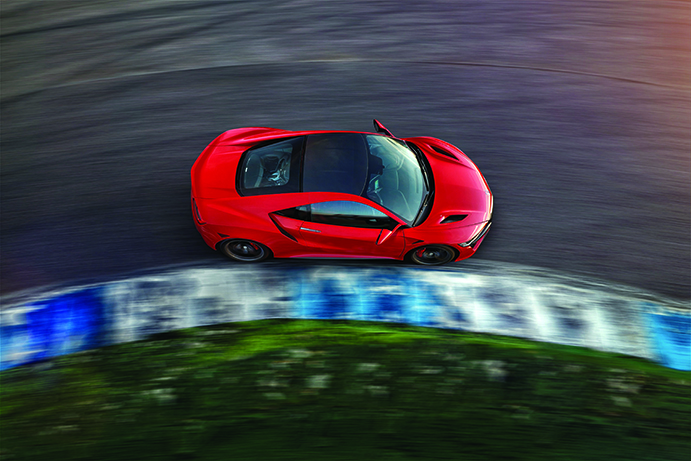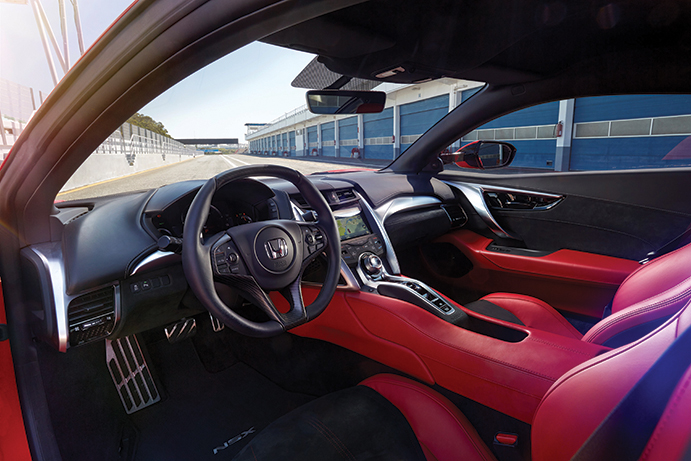The new Honda NSX is a technological tour de force, but can it still stir the soul? Chris Pickering reports.
Sometimes, progress can be a mixed blessing. While cars have undoubtedly become quantifiably better in recent years, the same technology is often to blame for eroding the sense of connection that keen drivers crave.
The high-revving naturally aspirated V8s and V12s that once caused petrolheads to get all hot under the collar, for instance, are now an endangered species, while the manual gearbox is all but extinct on high-end performance cars. Likewise, the switch to electrically assisted steering may help to shave a few precious grams of CO2 per kilometre, but it invariably robs a great deal more when it comes to tactility and feedback.
So, with this in mind, I approached the new Honda NSX with a degree of trepidation. On the face of it, a mid-engined supercar capable of 0-to-62mph in ‘under three seconds’ and the best part of 200mph can only be a good thing. There again, it’s also a technological tour de force, packed with a multitude of clever features that stand to make or break the driving experience.

Where to start? Well, there’s the obligatory downsized turbo engine – in this case a 3.5-litre V6 making 500bhp – but here it’s combined with a trio of electric motors. In between the engine and the nine-speed (yes, nine-speed) dual-clutch transmission lies a 47bhp motor, while each of the front wheels is powered by its own 36bhp motor.
Due to the differing speeds at which the four power units reach their peak, these figures can’t simply be added up. Instead, Honda tells us the combined total is 573bhp. That’s more than the similarly priced McLaren 570S or the Porsche 911 Turbo. What’s more, the use of individual motors for the front wheels gives the NSX not only four-wheel drive, but also torque vectoring.
The bank of lithium-ion cells that supplies the electrical half of the powertrain is slung behind the seats, while the power electronics sit in the central tunnel between the driver and passenger. Both are mounted low down, helping to give the NSX the lowest centre of gravity in its class, according to Honda. That’s fortunate, because it weighs a not-inconsiderable 1,814kg.
Quiet mode
Perhaps surprisingly, the NSX doesn’t have a plug-in capability and there’s no electric-only mode as such. There is, however, a Quiet mode, which allows the car to run on electric propulsion whenever possible, as well as closing a series of valves to channel the exhaust gases through additional silencers. It means you can glide serenely away from the traffic lights, but where’s the fun in that?
In any of the NSX’s other increasingly visceral driving modes (Sport, Sport+ and Track) things are rather different. The V6 begins with a deep, mechanical growl that builds into a proper supercar crescendo. It only revs to a comparatively mild 7,500rpm, but thanks to the wonders of hybrid assistance there’s meaningful torque practically from tickover. That means when you reach the red line – exhausts bellowing and licence under threat – it feels like you’ve been flat out for a good 7,499 of those rpm.
Crucially, the electric motors also provide torque filling before the turbochargers wake up, which means the throttle response is both instant and unswervingly linear. It feels like a really well-sorted naturally aspirated engine – just one with disproportionate power and torque for its size.
You rarely hear anything to give away the presence of the electric motors, but more impressively you never really feel them either – even under braking. Often, hybrids have a rather wooden feel to the brake pedal as the electrical system harvests its energy, but not so in the NSX. It isn’t just good for a hybrid, it’s good full-stop.

The dual-clutch gearbox is also deeply impressive, even by the standards of what is now a very accomplished breed. Not only are the shifts smooth and lightning fast, but the unfeasibly large number of ratios actually feels totally natural once you’re on the move. It’s essentially a 7+2, with first only used for pullaway and ninth only for cruising.
And so we come to the steering. Not only is it electrically assisted, but it’s also a variable rate rack. By rights, it should be horrible. In reality, it’s rather good. There’s not quite the same level of feedback as you’d get from the McLaren 570S’s fixed-rate hydraulically assisted rack, but it feels pleasingly natural. The only clue to the variable rate is the fact you can negotiate all but the tightest turns without taking your hands off the wheel.
Pitch it into a corner and the NSX feels spookily agile for a car that weighs as much as two Lotus Elises stacked on top of each other, yet it’s also calm and composed at speed. That’s an unusual combination, made possible by the ultra-low centre of gravity, plus the subtle effects of the variable-rate rack and the torque vectoring system. It’s still not quite as light as the McLaren, but it would give an Audi R8 or a Porsche 911 Turbo a good run for their money.
And so, there you have it. A four-wheel-drive, hybrid supercar, built in the US by a Japanese company, which is capable of taking on the best of the European elite. But the real story here is that by combining lots of different technologies, Honda has produced a car that actually feels more analogue – more traditional, if you like – than we ever dared hope. Maybe the future isn’t so bleak after all?




Red Bull makes hydrogen fuel cell play with AVL
Formula 1 is an anachronistic anomaly where its only cutting edge is in engine development. The rules prohibit any real innovation and there would be...